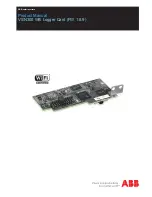
7-4
|
ni.com
Chapter 7
Counters
Single Point (On-Demand) Edge Counting
With single point (on-demand) edge counting, the counter counts the number of edges on the
Source input after the counter is armed. On-demand refers to the fact that software can read the
counter contents at any time without disturbing the counting process. Figure 7-2 shows an
example of single point edge counting.
Figure 7-2.
Single Point (On-Demand) Edge Counting
You can also use a pause trigger to pause (or gate) the counter. When the pause trigger is active,
the counter ignores edges on its Source input. When the pause trigger is inactive, the counter
counts edges normally.
You can route the pause trigger to the Gate input of the counter. You can configure the counter
to pause counting when the pause trigger is high or when it is low. Figure 7-3 shows an example
of on-demand edge counting with a pause trigger.
Figure 7-3.
Single Point (On-Demand) Edge Counting with Pause Trigger
Buffered (Sample Clock) Edge Counting
With buffered edge counting (edge counting using a sample clock), the counter counts the
number of edges on the Source input after the counter is armed. The value of the counter is
sampled on each active edge of a sample clock and stored in the FIFO. A DMA controller
transfers the sampled values to host memory.
The count values returned are the cumulative counts since the counter armed event. That is, the
sample clock does not reset the counter.
You can configure the counter to sample on the rising or falling edge of the sample clock.
Co
u
nter Armed
S
OURCE
Co
u
nter V
a
l
u
e
1
0
5
4
3
2
Co
u
nter Armed
S
OURCE
P
aus
e Trigger
(P
aus
e When Low)
Co
u
nter V
a
l
u
e
1
0
0
5
4
3
2
Содержание 6368
Страница 1: ...PXIe 6368...













































